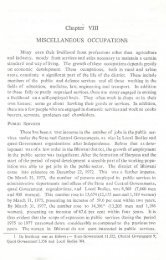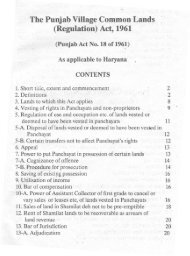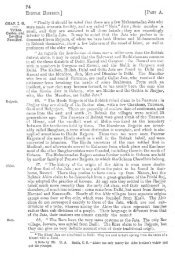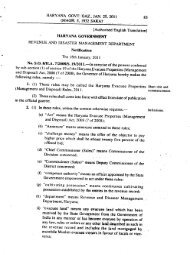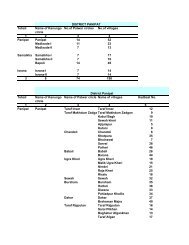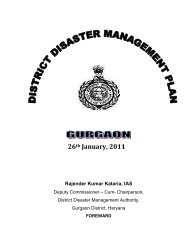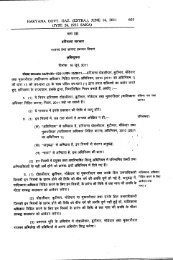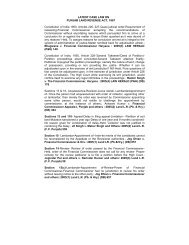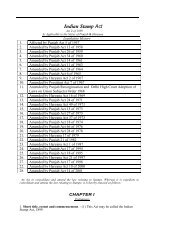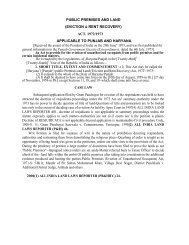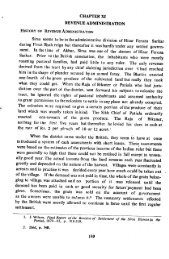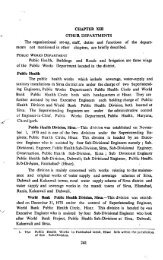chapter - iv - revenue and disaster management department, haryana
chapter - iv - revenue and disaster management department, haryana
chapter - iv - revenue and disaster management department, haryana
You also want an ePaper? Increase the reach of your titles
YUMPU automatically turns print PDFs into web optimized ePapers that Google loves.
qhapter 1,1.<br />
History.<br />
J'oJ'mation of the<br />
district.<br />
CHAP. n.-THE HISTORY.<br />
[Punjab .Gazett;~r<br />
'The district of Thanesar included the estates of Thanesal'<br />
which lapsed tths in 1832 <strong>and</strong> the remaindEJr in 1850 ; Kaithal<br />
which lapsed in 1843, <strong>and</strong> Ladwa. confiscated in 1846. Up to<br />
1849 these estates had. been administered by the Political<br />
Agent of AmbaJa <strong>and</strong> his Assistants. In that year, being incorporated<br />
with the Punjab, they were formed into one district<br />
under a Deputy Commissioner subordinate to the Commissioner<br />
of the Cis-Sntlej D<strong>iv</strong>ision. In 1802 the district was abolished<br />
as a separate charge, <strong>and</strong> its territory distributed between the<br />
districts of Ambala <strong>and</strong> Kamal. The parganahs of Shahabad,<br />
Laciwa, <strong>and</strong> apart of 'fhanesar feH to Ambala, <strong>and</strong> the remainder,<br />
including Kaithal, went to Kamal. l'he tahsils were at the<br />
same time remodelJerL They had previously consjsted of (1)<br />
Kaithal, (2) Gula, which included the Pehowa tract now in<br />
Karnal, (3) 'l'banesar, <strong>and</strong> (4) Ladwa. The last two included<br />
the villages now forming tbe lndri parganah of the KarnAl<br />
tahsil. In 1866 the Pehowa parganah was transferred from<br />
Karnal to Ambala, but in 1876 14 villages, <strong>and</strong> in 1889<br />
the remaining 89 vilbges were again transfi?rred from<br />
Pipli to the Kaithal tahsil of Kamal. The present Ambala<br />
district comprises almost the whole of 81, Sikh ih\kas. The most<br />
important l~pses of jag! r estates since the first regular settlement<br />
have been due to failure of heirs in the Sialha estate in<br />
1866 <strong>and</strong> in Manimajra in 1875. The lapse in the former case<br />
covered 63 villages with a <strong>revenue</strong> of Hs. 29,000 <strong>and</strong> in the latter<br />
69 villages with a <strong>revenue</strong> of Rs. 39,100.<br />
The fonowing statements g<strong>iv</strong>e lists of officers who have<br />
heM charge 01' the Ambala <strong>and</strong> TllltUeSar distl'icts respect<strong>iv</strong>ely,<br />
in recent years, omitting' temporary appointments in which an<br />
officer's tenure lasted for a few months only.<br />
Captain Blair 'r, Reid<br />
T. D. Forsyth, Esquire<br />
P. S Mel,ill, Esquire<br />
Cantain A. L. Busk<br />
;. J. S. 'l'igbe<br />
C. P. Elliott, Esquire<br />
C>Lptain J. S. Tighe<br />
" C. Beadon<br />
O. P. Elliott, Esquire<br />
AMBALA DlSTRICT.<br />
1855<br />
1856<br />
1858<br />
1859<br />
1863<br />
1867<br />
1867<br />
1871<br />
1872<br />
Captain J. Fendal!<br />
." E. P. Gurdon ..<br />
T. W. H. Tolbort, Esquire ...<br />
J. Frizelle, Esquire<br />
A. R.. Bulman, Esquire<br />
J. C. Brown, }tJ~quire<br />
A. R. Bulman, Esquiro<br />
J. C. Brown, Esquire<br />
A. R. Bulman, Esquire<br />
C. E. Gladstone, EsqUIre<br />
I Dates.<br />
1875<br />
1877<br />
1879<br />
1882<br />
1883<br />
1884<br />
1884<br />
1887<br />
1887<br />
1890<br />
Kames. Dates. Names. Dates.<br />
----------- ---- ---<br />
Captain A. L. Busk ... 1859 Captainl!'. J. Millar ... 1861<br />
" A. J. Hll.we~ ... 1859<br />
H. H. Umrston ... 1861<br />
N. W. Elphmstone ... 1860 ., W. G. Davie~ ... 1861<br />
" F. S. Graham .., 1860 Colonel F. S. Voyle ... 1862<br />
"<br />
"
Ambala District.]<br />
CHAPTER III.<br />
Table No. V g<strong>iv</strong>es separate statistics for each tahsil <strong>and</strong><br />
for tlle whole districr, of the distribution of population over<br />
towns <strong>and</strong> villages, over area, <strong>and</strong> among houses <strong>and</strong> families;<br />
while the 'number of houses in each town is shown in Table<br />
No. XLIII. Tbe statiRtics for the district as a whole g<strong>iv</strong>e the<br />
following figures. furtliel' information will be found in the Cen-<br />
sus Report of 1891:- ,<br />
"" (Persons<br />
Percentage of tota.l population who li\·e in villa-goB ~ Males<br />
\'b'emales<br />
AverR.ge rural population per village ...<br />
AverRge total population per vill:l7,8 <strong>and</strong> town<br />
Number of villrtg~s per lOt) square miles ...<br />
Average distance from village to vill:l.g-c, in miles<br />
\ Total areu.<br />
Density of popUlation per, Clll'vltted arelt<br />
sqnal'e mIle of J t 1<br />
, ~ Culturable area<br />
Numbel' of resident families pel' occupied house<br />
Number of persons per occupied house<br />
Knmbe"r of persons per resident family<br />
j'l'otal population<br />
~ R.ural population<br />
{ ~J'otal popullttioll<br />
Rural population<br />
f ,:rotal population<br />
l Rur,,1 population<br />
{ Village.<br />
~. 'l'ovnll:.~<br />
{ Vill ••"e.<br />
,., '!'r,wad<br />
fVill",,~.<br />
... t Towns<br />
86'47<br />
47'19<br />
39'28<br />
424<br />
488<br />
88<br />
1'15<br />
428<br />
371<br />
6a2<br />
589<br />
568<br />
4Ul<br />
1'51<br />
1'4~<br />
6'88<br />
6'2l<br />
4'37<br />
4"15<br />
Chapter III, A,.<br />
Statistical.<br />
Distribution of<br />
• p
CHAP. Ilr.-THE PEOPLE.<br />
[Punjab Gazetteer:'<br />
Chapter III, A· ~ale~ <strong>and</strong> 63,090 females. The figures below show the genoral<br />
'Statistical. dlstrlbution of the population by birth-ph1ce :-<br />
Migration <strong>and</strong> birthplace<br />
of population.<br />
Increase <strong>and</strong> de·<br />
crease of population. '<br />
PROPORTION ?ER MILr.~ OF RE~lD-ENT POPUI,A-<br />
TluN BoR:\' I:.\i<br />
I '<br />
The dis· I Thc pro- \<br />
trict- vince. India.<br />
--- ---i------<br />
~ 9~1__~_~<br />
826 aG1 I SOD 999 '<br />
-865 -\--;,m-\- ~-1--996<br />
'l'he following remarks on the migration to <strong>and</strong> from Ambiila<br />
are taken frOID the Census Heport of 1881 :-<br />
" H'Ore the effec~ of largc cantonmcnts in attracting population from a distance<br />
is at oncc app,u'ent. 01 tbe \"iIlage popularioll 9:: per ccnt. is indigenous;<br />
of the town population ouly 73 per ccnt. 011 the other ba.nd, the emigration<br />
to 'Lahore a.nd J)'erozcpore, ;"here as lar;);e or larger cantomerlts exi~t" is<br />
in excess of the immigration. But as 1Je~ween Amblijlt <strong>and</strong> tpe districts which<br />
IDf1rch with it, thc rnigrat,ion is iu the direction of least pressure, ",nd the proportiun<br />
of emii1;rants to immigrants increases thl'Oughout, a, the density of population<br />
of the rec.e<strong>iv</strong>ing district clecreagcs, . The uniubabitahle bill nrl'3- included<br />
in A:m.bala makes the figures for deusicy on Lota-i area nlislt-~jlding, <strong>and</strong> those fOl·<br />
calt<strong>iv</strong>ated area afl'ortI a tr',el' mea.sure ,.f the pre;;sure of population. Excluding'<br />
Simla anti Delhi, the c.ircumshincos of which >:Te excepti,.nal, the migrar.ion to<br />
aud f•.£>rnAmbala consists in taking population fTom the more densely peopled<br />
Buhmontane dist!'icts, <strong>and</strong> g<strong>iv</strong>ing it 10 the moro sparsely I eopled tracts to the<br />
south <strong>and</strong> sooth-west, Speaking gelloralJr, Lhe. propol'~ion (lj' males shows that<br />
the elnigration to the districts {rOLl w.hich it is reectving', }1nd the immigrC:ttion<br />
of those to which it is g<strong>iv</strong>ing, are largely reciprocal iu their character; while<br />
the mo\·emeni3 in the (ipposite directiuns arc to a. g!:eat eX'Ct'l1t permanent, wiHi'<br />
a tendency to be temporary- in the ease or ~UUH.-\ of the mote distfl.nt district::-.<br />
1'he migratioll to alld from Kai',uil, Ludhiiina lIn
creased doring the ten years by 10,330, representing a.variation Chapter III. A,<br />
in the numbel' of troeps <strong>and</strong> follo\\'el's :'resent in the cantonments Statistical.<br />
on the day of el'umerntiun rathe" thnn a corresponding<br />
. h' l' f h 1 . . '<br />
III t e perrnanen t popu atlOll 0 t e (,lstrIet/ .<br />
increase<br />
•<br />
I<br />
Dcrease <strong>and</strong> d~.<br />
crease of population<br />
It was calrulnted in 1'';;81 tbat arconling to the normal<br />
inCI'('fl.se of pOPlllatioll' as t]Wll :t~certained the total for the<br />
district in 18~11 would be 10,98,100, or allowed for the transferred<br />
viilnges 10,63,500. The aetual figure by the 1891 Census<br />
return is 10,33,427, or about 30,000 less than was anticipated.<br />
The compIE-tion of the Sirhimi Canal works in 1b82 is to some<br />
smail extent a rPflson fOl' the non-fulfilment of the fstirnate of<br />
1881, as with the opening of the canal the Rupar convict gaol<br />
W::IS tral1~ferred p1sewlJere <strong>and</strong> a considerable army of free<br />
laborersJeft the district in se-arch of otl1Pr employment.. Possibly<br />
this may accol1ut for from Lt,OOO to G,OOO souls in :-111, For the<br />
rest it may be hiken that the district has been fn11y populated<br />
for the last twenty years <strong>and</strong> Ibat there is little scope for material<br />
. incre3s(~. Moreo\'er p'lrt" of the dist.rict, especially the Ma,nimajra<br />
tract of tahsil Kharfll' <strong>and</strong> the southern ponion of tahsIl<br />
Pipli are llotOI'ious]y unhealthy, w]lile the whole of t,he four<br />
southerntahsils nre liable to seyere epidemics of fever, as in the<br />
year 1884, "Lich eHect.ual!y preveut that normal increase of<br />
population which might otherwise be expected.<br />
'I'he total urban pupulat,iou was returned at 1,40,332 in<br />
1881 <strong>and</strong> 1,;j9/~65 in J891. Kharar <strong>and</strong> Radanr ceased to be<br />
classified as tow ns in 189), w hi Ie t,he Pehowa town wa,s kansferred<br />
to Karnal in 1~89, Allowing for these c1langrs the urban<br />
population in tIle r,>maining towns of the district is ] l,10G<br />
larger than in 188t,! bnt nearly the whole of the increa.se is<br />
acconnted fOt, 1.:ythe adri.ition of J 0,330 in Ambala Oantonment<br />
which depends largely on accidenta.l circumstances.) The urban<br />
population propt·rly so called has therf>fo!'e remained nearly<br />
stationary. Jagadhri town has increased by 729 during the<br />
decade, Ambah city <strong>and</strong> CiyilLines by 1,501, ShaM,bad by<br />
1,255, <strong>and</strong> Th,inesar hy lOG, In the remaining four towns the<br />
lS91 fignres sllOw some decreasf~, 'l'he only considerable decl'ease<br />
(1,633) is in R opal' fown, <strong>and</strong> this is accounted for by}he closing<br />
of the Sil'hind Cetnal construction works at Rllpal'. r The towns<br />
of the district are<br />
T P Ipereentage all petty pIttces of<br />
. O"AL OPULAnON. of populo.- no such commercial<br />
- tion o· 1891 '<br />
____________<br />
1881.<br />
au tJ;at of<br />
1891. 1881.<br />
.______ I<br />
Importance as to<br />
l~ad to an expecta~<br />
bon ·of much d€>-<br />
'Ambala<br />
Kharar<br />
Bup"r<br />
Naraingarh<br />
J~g:a.'lhri<br />
PIpit<br />
... - 2,20477 2,30.5671<br />
., 1,67,869 ],68,6-1.2<br />
.. , 1,54,:103 I ]'46'8161<br />
.. ' I 1.45,633 I ],41,3l6<br />
, I ],69,640 I 1,68,634<br />
, I 2,09,341 1,77,442<br />
105<br />
lOll<br />
95<br />
97<br />
99<br />
85<br />
ve10pment) Inc1u~<br />
s<strong>iv</strong>e ofthe towns the<br />
-, t" I<br />
v,arm IOnltl popu a-<br />
tlOn by tahslls smce<br />
18S1 is shov,-n in<br />
Total Districts.. 1,067,263\' 10,33,4271--97- the mal'gi~. It ':I'ill<br />
_ be borne .III mIlld
Ohapter III, A. that the transfer of villages from Plpli. in 1889 vitiates the figures<br />
'Statistical. for that tahsil <strong>and</strong> for the total district for purposes of com-<br />
.<br />
. Distributiou of<br />
popnlation.<br />
pariRon, <strong>and</strong> that t,le increase in tahsll Aillbiila<br />
dd" I I' f I<br />
a Ihona popu atlOll 0 cantonments on y. ,<br />
is due to tbe<br />
Births <strong>and</strong> deaths. Table No. XI sllows the total number of births <strong>and</strong> deaths<br />
registered in the district for the ten years from 1882 to 1891.<br />
The distrilJUtion of the total deaths <strong>and</strong> of the deaths from<br />
fever for these ten years, over t.he 12 months of the yeaI' is<br />
shown, in Table Nos. XI A <strong>and</strong> XI B. 'l'he figures below<br />
show the annual birth <strong>and</strong> death rates per mille sinoe 1882,<br />
calculated on the population of 1881 up to 1890:-<br />
.,; <br />
ro CD 00 00 00 00 00 00 00<br />
...• ...• ...• ...• ...• ...• ~ ...• ...•<br />
- - - - - -, - - - ---<br />
32 37 34 27 32 30) 28 32 30 32 31<br />
2-7123 54T2'6 28136 'Wt25T41 32 - 32"-<br />
The· registration is still imperfect., though it is yeorly<br />
improv:ng j but the figures alway s fall short of the facts, <strong>and</strong><br />
the fluctuations pl'obably correspond, allowing for a regular<br />
increase due to improved reg-istration, fairly clOflely with the<br />
actual fluctuations in the births <strong>and</strong> deaths. The his! orical<br />
retl"Ospect which forms the first part of Cha.pter HI of the<br />
Census lleport of 1881, alld especially the annual chronicle from<br />
1840 to ,1881 which will be foulld at page 56 of that report,<br />
throw some light all the fluctuations. Slieh further details as<br />
to birth aud death rates ill indi vidual towns as are available will<br />
be foupd in Table No. X LIV <strong>and</strong> under the headings of .the.<br />
sever~l towns in Ohapter VI.<br />
Age; sex, <strong>and</strong> c<strong>iv</strong>il The figlfn;s for age, Sex find c<strong>iv</strong>il condition are g<strong>iv</strong>en in<br />
condition. great detail in Table Nos. VII <strong>and</strong> VIII of the Census Report<br />
of 189 I, while the nnm bel'S of the sexeR for each religiou will be<br />
found in Table No. VII appended to the pt'esent work. 'l'hG<br />
agestat.istics must be taken sullject to limitat.ions whieh will be<br />
found fully discussed in Chapter VII of the Census Heport for<br />
1881. Their value rapiflly dimillishes as the numbers dealt<br />
with become smaller j <strong>and</strong> it is unnecessary here to g<strong>iv</strong>e actual<br />
figures, or any statistics for t,tllsils. The following figures. show<br />
the distribution by age of every 10,000 of the population<br />
according to the Census figures of 1891 :-<br />
, I 0-1 1-:!'--2-3 I 3-414-5 0-4 5--9 !10-1415-19<br />
~-- .. -. 'I 36(; 265 -2561 264/289 1,4:39' ~;-;7; 1,173 1,132<br />
Females __ .._. ~ 289 :!95 I 283 ~87 1,577 1,17~ 1,029 J,162<br />
______ /1 20 - 24 25-29/.30-34;35.- 39 ·40-44/'45-49/'50-:54 55-5fJ (~v~~~<br />
Males . 1,058 11,029 1 691 I 688 333 493· 174 350<br />
1<br />
I 2€2<br />
Females 1,036 1,045 605 727 318 553 145 373. 253<br />
j
The number of males among every 10.000 of both sexes<br />
in ] 891 is 5,490 as against 5,600, 5,485 <strong>and</strong> 5,512 according to<br />
tLe returns of the three previouR enumerations of 1855, 1868<br />
<strong>and</strong> 188.1. The proportion varies slightly for the different<br />
reliaiulls or tue country. The TlumbOl' allJong ChristiH.lls is 8,388,<br />
thisohiO'h rate of proportion being obviously due to the large<br />
numbe~ of nnmarried men in the British ti'OOpSof the garrison.<br />
In the Census of 18!)1, the number of females per 1,000<br />
males in the<br />
I earlier JeilTS of<br />
\11 life was found<br />
YCear_Oflife. figi::'~. I Hindus. Sikh~. Mnsalma_os to be flS shown<br />
I<br />
in tbe margin.<br />
0-1<br />
1-2<br />
2-3<br />
3-4<br />
4-;:;<br />
983<br />
89'6<br />
888<br />
894<br />
812<br />
I<br />
I<br />
934<br />
884<br />
926<br />
880<br />
803<br />
886<br />
783<br />
860<br />
743<br />
758<br />
1,018<br />
861<br />
1,008<br />
925<br />
8-1-8<br />
The figures for<br />
"1 d' .<br />
ClVI con It10n<br />
are g<strong>iv</strong>en in<br />
Table No. X,<br />
which shows<br />
.-- --- - I",-~- __ - .___________ t.he act u a, I<br />
number of single, married fmd widowed for 0ach sex ill each<br />
religion, <strong>and</strong> [~bo the di;;tl'ibutiou by c<strong>iv</strong>il condition of the total<br />
number of each sex in each age--period.<br />
Table No. XII shows the Humbcr of insane, blind, deaf-<br />
. -------------- ------.-- l11ut,es <strong>and</strong> lepers ill the district<br />
Males. I Females. iu 1881 <strong>and</strong> 189 J.<br />
tious pel' 10,000<br />
The proporof<br />
eitber sex<br />
------1---<br />
1~~:~e I<br />
, Deaf ar,d dumb<br />
4~<br />
13<br />
----<br />
5~<br />
8<br />
for elich of these infirmities are<br />
shown in the margin. Tables<br />
Nos. XlI, to XV, of tlie Censun<br />
Leprous<br />
I ,<br />
5 1 Hc-port for 1891<br />
details of the age<br />
g<strong>iv</strong>e<br />
<strong>and</strong><br />
further<br />
caste of<br />
the infirm. Ambala, which is third in order among the Punjab<br />
districts in respect of total population, st<strong>and</strong>s second iu respect<br />
of the number of insano, third as regards deaf-mutes, first as<br />
regards the bJina. <strong>and</strong> second as regards lepers. The number of<br />
lepers in tlH' district is somew hat large in cOllseq uence of the existence<br />
of a Leper Asylum at AmM.la. The number of persons<br />
affiicted with blindne"s is lamMltably great. The proportion per<br />
10,000 in the case of each infirmity is somewhat lowe:' than by the<br />
corresponJing figuros for 1881, but it is probahle that this i
Chapter' III, A:<br />
Statistical.<br />
CHAP. IlL-THE' PEOPLE..<br />
European <strong>and</strong> 'rhe figures g<strong>iv</strong>en in the mal'gm show the number of the<br />
Eurasian population. ,7=====..o==============:<br />
_ I -",~s~<br />
__ -~ I ~<br />
Ohristian<br />
pact<strong>iv</strong>e<br />
tion, <strong>and</strong><br />
popnlanumbers<br />
the res-<br />
~:<br />
[Punjab Gazetteer; .-<br />
"These villages are fI'ightfully under.populated. 'fhere are but few<br />
wells, <strong>and</strong> the G.hag!!ar\Vateris.~,'unk. Fever is cxtens<strong>iv</strong>ely prevalent, as is<br />
"ro,ed by the cllsrend,'dsple~lI0' almost e"ery ll,ird mau. A,k 11 man to tuu<br />
a few ~'lUdI:~dyards 0llolli!8ideofyonr horse. ur,.clbc is immE'di,\telyst9Pped by<br />
a COUg.lIllgilt ; wlIereasa Jar, ItVlDgout of the lllfluenceof irrio-"lion willrun<br />
a couple (,r u~il~swillI th'~ greatc3c ease. GuiLre (called !lill,,~h) i,: very pre.<br />
vuleut ; <strong>and</strong> It IS by no mea"s llUC"lUmonto find fonr, f<strong>iv</strong>e01' 8i: port for 1891.<br />
'" Total European_la_D_gDag~I~,_0_94_ .. _64_1_::,"_"3_5 . Tr.e number of<br />
British Isles, ." 3,608<br />
Other Enrvpeancountries 9<br />
Total European counLI·ias/3,617<br />
America." ... 13<br />
Australia... ." 1<br />
At sea ... ... I 9<br />
210 3,818<br />
10 19<br />
- 221;)3,837<br />
8 21<br />
3 I 4<br />
3 I 12<br />
troops stationed in .<br />
the district is g<strong>iv</strong>en<br />
in Ohapter V, tllld<br />
the distribution of<br />
Christians by<br />
tahsils is shown in<br />
'I'able No. VII.<br />
The Deputy Commissioner writes in the Census Report of the<br />
jIistrict that the Ohristin'u population of Rharar, where there<br />
al'e resident missionaries, is in a fairly flourishing state .. There<br />
are small comruuuities of Nat<strong>iv</strong>e Ohristians also at Jagadhri <strong>and</strong><br />
at Morinda in tahsil J{upar·. The totai number returned as<br />
Nat<strong>iv</strong>e<br />
262.<br />
Ohristians in the district in 1891 is 367, <strong>and</strong> as Eurasians<br />
SECTION B.-SOCIAL AND RELIGIOUS LIFE.<br />
The villages are generally compactly built, on ground a<br />
lit.tle raised, wit h one or two principal JanRs, about eight or ten<br />
feet widE', running throngh j·hem ; from these lanes other blind ...<br />
patlls branch off to the different ha'IJelis or houses. In he<br />
Khiidir', between the Jamna <strong>and</strong> the cftual, the houses are I<<br />
generally on high ground, to avoid illlmdat,ions. To' the west<br />
of the canal they are ::milt all tbe bigb. (dhal1g) precipitolls<br />
bank of the aIr! ,Tamna. ;. by this plan the people are near tbe<br />
water, <strong>and</strong> genpl'ally conveniently situate-d for theit, Btingar, as<br />
well as their Khfi.dil' hnds. The bonses ?re genemlly smeared<br />
with mud, OUCf! a yeal' after the rains, which g<strong>iv</strong>es them a tidy<br />
appearance. Thatched houses (chappars) are cheaper than
kothas, but they are. colder in the winter, <strong>and</strong> generally inhabited<br />
by the lower castes, GujarR, Ohuralls, Oha.mars, &0.) &0. It is<br />
considered a sign of an inferior village to have more chappa1's<br />
than kothas. 'l'he Rajputs, bot.h Hindus <strong>and</strong> Mussalmans, the<br />
Jats, Kambohs <strong>and</strong> Brahmans, are all comfortable about their<br />
hOllses.<br />
ChllpterIlI, B.<br />
Statistical.<br />
Villages.<br />
In the Khadir tracts, <strong>and</strong> generally near the hills, the R~UB~B <strong>and</strong> dovillages<br />
are for the greater part cum posed of thatched huts, mestlc hfe.<br />
their walls, made from the s<strong>and</strong>y soil, pot being able to bear<br />
the weight of a lleavy roof. In many parts the cottage roofs<br />
are overgrown with gourds, whose large green leaves <strong>and</strong> bright<br />
flowers 'of white or yellow present a very picturesque appearance.<br />
In the Morni hill tract the people are 0ften comfol·tably housed<br />
in substantial cottages with good stone walls. In the remainder<br />
of the district, the walls of the houses (koth(ls) are of mud, a"<br />
clods of dry earth, taken out of tJle tanks when they are dried<br />
up, or hom the dried up <strong>and</strong> cracked rice fields .. ThA roof of<br />
the 1.:otha is also of-mud; the beams which support it, ami whieh<br />
.are prine-ipaUy made of sal wood, rest partly on tlw mud walls<br />
<strong>and</strong> partly on upright beams a,bout six feet Jligb. AcroRs these<br />
lie smaller hearns, <strong>and</strong> over tltesA grass; lastly JJpon the b'Ta8s<br />
about. three inches of earth is laid. Some of tlJe houses posseSH<br />
a chimney, or rather a. hole ilL the roof, to Jet the smoke ~scape.<br />
It is a] ways made in the middle of the room <strong>and</strong>. covered up<br />
wit.h an earthen pot when it rains. Every house has its kathu,<br />
a large chest made of earth, <strong>and</strong> ID::>reor less ornamented<br />
according to the taste of th e owuer, about f<strong>iv</strong>e feet square outside<br />
<strong>and</strong> fOllr inside, wit,h a
Chapter III, B,<br />
Social <strong>and</strong><br />
Religious Life·<br />
The dress of the men consists of a turban, twisted ronnd<br />
a skull cap; a dhoti, or clot.h fastened ronndtbe waist, <strong>and</strong><br />
drawn up between the legs; shoes; <strong>and</strong>, ill the -cold weather,<br />
a sheet, or counterpane stuffed wit.h cctton. Only a few of the<br />
better dressed men weal' the chapkan (jacket) or m·i1'zai (coat),<br />
so common in the province. The fact ·is that only a few or the<br />
zamiudars have hitherto been ~iUfficiently well off to afford these<br />
luxuries. Those who can afford it wear a thin cotton jacket<br />
in the hot weather <strong>and</strong> rains, <strong>and</strong> one of dyed cotton stuffed,<br />
or padded, in t.he cold weather.<br />
Food of the people. The following note regarding the feod of the people was<br />
furnished by the district authorities for the Famine Report of<br />
18'19 :-<br />
•<br />
"'£he staple food of the people of the Arubala. distl'ict at rabi is principally<br />
wheat <strong>and</strong> gram. Thongh in less ({uautities than wheat, dd.l is also largely<br />
consumed. At kharif the principal food is 'liakki, j'owcir, Lci)"a" <strong>and</strong> chiJla; ddl<br />
is also eaten with these. The raui graius above mentioned are sown from the<br />
15th September to 15th November, wheat being sown last of all. The rabi<br />
harvesting begins from 1st April, <strong>and</strong> ranges generally up to the 10th ApriL<br />
The kharif grain crops cult.<strong>iv</strong>ation depends upon )'ain fallillg ; if rain has fallen,<br />
they, i. e" the crop", would be sown by the 15th Jnne, <strong>and</strong> later, according as<br />
the )'ain way happen to fall. 'l'he khal'lf harvesting commences from the 1st<br />
September (when china is generally ripe), [l,nd g-oes on till about tho end of<br />
October. '<br />
" It is essential for the well-being of futnre rabi crops Lhat rain shonld fall in<br />
September, or iu the latter portion of BI,ndon <strong>and</strong> begiuning of Asanj; in<br />
short, copious rain thronghout August, although belleLicial enough for the<br />
st<strong>and</strong>ing kharif crops, will lIot suffice for I;, good aud ample rabi, unless some<br />
rain also fall in September; rain agRin is most essential duriug the month of<br />
December, <strong>and</strong> agaiJJ iu February; rain dnring thes_e months will generally<br />
seeure a copiuus crop. Rain is nut de;;iri1ble for a month or ~o nfter 'oIYillg. ]'01'<br />
the khar[f it is most essential that rain should, if possinle, faU by the 15th June<br />
01' about the 1st Asarh, aud it will be all the better if there be r,)in more or leBs<br />
onue a week nntil the end of September. If the month of Asarh pass entirely<br />
without any rain, there will he no COLtoncrop <strong>and</strong> otuer staples will be limited.<br />
Rain is very de1'lirable a.~d beneficial when the grain is jost comiug into ear,<br />
<strong>and</strong> for want of it then the grain will be short in quantity."<br />
The following is au estimate of the food grains consumed<br />
in a )'eal' by au aV6l'age agriculturist's family of f<strong>iv</strong>e persons;-<br />
Rabi-<br />
Wheat<br />
Gram<br />
Dci.l<br />
Kharif-<br />
Makki<br />
JoWc1"<br />
Bd.jm<br />
China<br />
Ddl<br />
Rabi-<br />
Wheat<br />
Gram<br />
Ddl<br />
Sers.<br />
2<br />
2<br />
o<br />
1<br />
1<br />
1<br />
1<br />
o<br />
Cht8.<br />
n<br />
5<br />
OMs.<br />
J2} 12<br />
8<br />
Ser8 per diem) M. S. Oh.<br />
for 6 months, or ~ =22 32 8<br />
182~ days. ) .<br />
5 sers per diem 3<br />
for 6 mouths, 01' = 22 32 8<br />
182~ da;rs. ,<br />
40ers pel' diem ~ ~f. S. Ch.<br />
for 6 mouths, or =18 10 O.<br />
1821- da.ye.
Kharif-<br />
Makki<br />
Jo\Yar<br />
~814 sers per diemI<br />
{ell: ,6 months, or 18 10 0<br />
Bajra<br />
Dat 8 182. days.<br />
Rabi-<br />
Wheat .•.<br />
Gram<br />
Dill<br />
Kharif-<br />
Wheat ...<br />
Makki<br />
Val<br />
Table No. VII. shows the numbers in each tahsil <strong>and</strong> in the<br />
whole district who follow each religion, foS ascertained in the<br />
Oensus of 1891, nnd Table No. XLIiI. g<strong>iv</strong>es similar figures for<br />
towns. 'fables Ill, IlIA. <strong>and</strong> IlIB. of the report of that<br />
Oensus g<strong>iv</strong>e further·details on<br />
1<br />
I Rural Urban Total<br />
Religions.l popula- popnla- popnla:<br />
tion. tion. tion.<br />
Hindu ...<br />
Sikh<br />
Jain<br />
Mus~al Ul an<br />
Christian<br />
6,271<br />
997<br />
8<br />
2,73~ I<br />
5,044<br />
328<br />
153<br />
4,064<br />
356<br />
6,105<br />
906<br />
27<br />
2,911<br />
50<br />
J tion<br />
Cbts.<br />
n<br />
S.<br />
Ch.<br />
3 12 per diem} M. S. Cb,<br />
for 6 months, or =17-4'6<br />
182i days. .<br />
4" 3 12 per diem 1<br />
o ( for 6 months, or =17·4·6<br />
8 J 182~ days.<br />
Total maunds ... 34812<br />
the su bj ect. The distribu~ion<br />
of every 10,000 'of the population<br />
by religions is shown in<br />
the margin. A full descrip-<br />
of the great religions of<br />
the Punjab, <strong>and</strong> of their principal<br />
sects, will be found in<br />
Ohapter IV of the Oensus<br />
Report for 1881. 'fhe religious<br />
practice <strong>and</strong> belief of<br />
the district present no -special<br />
peculiarities; <strong>and</strong> it would be out of place to enter here into any<br />
disquisition on the general question. The general distribution of<br />
religions by tahsils can be gathered from the figures of Table<br />
No. VII; <strong>and</strong> regarding the population as a whole, no more<br />
detailed information as to locality is available.<br />
A complete account of the religious sects <strong>and</strong> of their<br />
various ceremonial observances on the occasion of birth8, deaths<br />
or marriages, <strong>and</strong> of other occnrrences connected with the dailv<br />
life of the people, has been g<strong>iv</strong>en in the Karnal <strong>and</strong> Ludhiana<br />
volumes of the Provincial Gazetteer. It is unnecessary to reo<br />
peat herd the substance of what has been elsewhere discussed<br />
in ~reat detail <strong>and</strong> in a most interesting form, <strong>and</strong> the reader<br />
who requires further information on these subjects may be<br />
referred to the volumes specified. There is little requiring.<br />
special uotice under"this head in Ambala. Among the Hindus,<br />
the followers of Vishnu <strong>and</strong> of S<strong>iv</strong>a are fairly evenly balanced.<br />
Vishnu is worshipped under several of his incarnations, that of<br />
Chapter III, lJ.<br />
Social <strong>and</strong><br />
Religious Life. -<br />
Food 'Of the people.<br />
General statistics"<br />
<strong>and</strong> distribution<br />
of religions.<br />
Religious sects<br />
<strong>and</strong> institutions.
Chapter III. B.<br />
Social <strong>and</strong><br />
Religious Life.<br />
Religions sects<br />
aud institutions.<br />
Fairs <strong>and</strong> religkus<br />
gathering3.<br />
[Punjab Gazetteer~ " ,<br />
Krishna bein,g'the most common. The principal days of worship<br />
at the thUJ~a1"d1Clira8 or temples of Vishnu are the 8tb of Bhadon,<br />
9th of Jeth, aud 14th of R;;isakh. The 8hi~ctilas or temples of<br />
Mahii.deo are especially attended on the 14th of Phagan. Devi<br />
is principally, worshipped as Si tab or small-pox, a visit to her.<br />
shrines being supposed to act as a safeguard ngainst that disease.<br />
The temples <strong>and</strong> bathing' pla~es on the banks of the<br />
Sarusti have already been alluded to. Among the minor deities;<br />
Hanuman is extens<strong>iv</strong>ely fH)l'sllipped in connection with Vishnu.<br />
'1'he Muhvmmadn.ll saints, Guga Plr <strong>and</strong> San-val" Sultan, are<br />
largely ]'eve]'ence~ as well by Hindus as by Mns!'~lm~ns'l At<br />
almost evel'j shrme 01' mosque thronghout the dlstnct, some<br />
sGrt of imtitntion exists for the benefit of travellers, supported,<br />
some by funds left by the founders or contribnted by their descendants,<br />
<strong>and</strong> SOUleby small grants of <strong>revenue</strong>-free l<strong>and</strong> assigned<br />
for the purpose by Government 01' the villnge. The principal<br />
institution of the latter class is the thtik(/1',lwam of Daya HAm<br />
in AmMla. city. ,i At Jagadhri an establishment is supported by<br />
a or.t<strong>iv</strong>e banker; from which 3. dole of half a serof Bon}'is daily<br />
g<strong>iv</strong>en to any traveller or pauper who may care to apply for it.<br />
Another nat<strong>iv</strong>e !;JankeI' .of,the srune towI! has built <strong>and</strong> 'eDdowed<br />
a commodious rest-house for indigent travellers. At 'l'La.nesar<br />
<strong>and</strong>' Pehowa, establishmelJts for the relief of travellers are<br />
maintained, the former by the Maharaja of Patiala, at a cost of<br />
Es. 7 per day, the latter jointly by the MaMnlja of Patia.la <strong>and</strong><br />
the Raja of NabLa. There are small coloni~s of Sikh dissenters<br />
(Kukas) Dear Ambala city, <strong>and</strong> in the neighbourhood of Chuni<br />
in the Kharar tahsil. They are quiet, orderly men <strong>and</strong> have<br />
g<strong>iv</strong>en DOtr.ouble since the great Kuka rising of 1872.<br />
The places of pilgrimage in the district al'e very numerous.<br />
The sanctit.y of the Sarusti <strong>and</strong> the Kurukshetra has been<br />
already noted TlJe prillcipal religious gat.herings at Thanesar<br />
take place on occ~sions of eclipses of the sun. Pilgrims atteud<br />
from all parts of India (see Chap. V I, heading "Thanesar").<br />
At Pehowa the sacred mouth is that of Chait (March-April), during<br />
w hieh a large concourse of peoplE', including pilgrims from<br />
a distance, is collected. Along the Sarusti, the whole year<br />
round, there is a constant succession of fest<strong>iv</strong>als at oue shrine<br />
.or another. 'l'he other religious fairs attended by pers~ms from<br />
a distance are at Rcipar on the banks of the Sl1tlej, where on<br />
April 11th large cr0wd's, amounting to as many as 50,000 persons,<br />
are collected to reverence the r<strong>iv</strong>er, at the spot where<br />
it issues from the hills; <strong>and</strong> at the shrine of Mansa Devi neal'<br />
Manimajra, where 80,000 persons are collected -in the month of<br />
Chait (March-April) <strong>and</strong> nearly as many in the month of<br />
Asauj (September,.October), to worship the goddess Devi as t1le<br />
patron saint of thieves. Pilgrims attend this s111'inefroDJ great<br />
distances. The attendance at these fairs bas much fallen off or<br />
late, years owing to the dislike of the people to the sanitary<br />
regulations rendereq necessary by outbreaks of chole.ra at<br />
'l'blinesar <strong>and</strong> Mani M:ijra, in 1861 <strong>and</strong> 1857, respecHvely.<br />
In quite recent years it has. been necessary to break up or alto~
gether prohibit some of the large gatherings at T~hanesar for<br />
fear of the spreafl of cholera .. 'fhe opening of railway communication<br />
with 'l'hanesar in 189 I has however done much to~<br />
facilitate the moveUl8nts (If pilgrims to that m{)st holy spot at all<br />
seasons of the year, <strong>and</strong> it, is now in a fair .way to recover the<br />
popularity to which it is entitled by its sanctity, to the no small<br />
advantage of the resident Bl-ahmans who subsist on-tlle offerings<br />
of the .faithfu1.<br />
There is a peculiar appropriateness in tll e p.xisteucfl of t,he<br />
famons Mansa Devi shrine at Mauimajra. withiu the confines of<br />
Amba,la, as cattlfl theft is an exceedingly common offence<br />
tll1'oughout the wild jungle country in the south of the district,<br />
<strong>and</strong> in not a few Gujar <strong>and</strong> Rajput villages of tijhsils AmMla<br />
<strong>and</strong>'Narningarh.<br />
Table No. VIII. sllows the numbers who speak each of the<br />
principal languages current<br />
Proportion per<br />
Language. I 10,000 of<br />
, I<br />
in the district separately for<br />
Poachtahsil <strong>and</strong> for th~e whole<br />
district. MOl'e detailed in-<br />
population.<br />
-- -------1-- --,formation<br />
will be found iri.<br />
Table No. IX. of the Census<br />
Hin~fustani-Hinui<br />
Paharl .....•<br />
... , 6,6]7<br />
5~<br />
Heport<br />
X. of<br />
for 1881 <strong>and</strong> Table No.<br />
the Report for 1891,<br />
Punjabi<br />
All Indian<br />
Non-Indian'<br />
... ... ,<br />
languaged I<br />
1<br />
3,262<br />
9,954<br />
46<br />
while 'in Ohapter V of the<br />
Heport for 1881 the several<br />
languages are briefly dis-<br />
----,-------- cussed. 'l'he figures. in the<br />
margin g<strong>iv</strong>e the distribution of every 10,000 of the population<br />
by language, omitting small figures. '1'he language Rp~ken<br />
is Puujabi in tnhsih~ Kharar <strong>and</strong> Rupm: <strong>and</strong> a rough Hindi<br />
~patois ill the rest of the district. '<br />
'fable No. XIII. g<strong>iv</strong>es statistics of education as ascertained<br />
at the Oensus of 1891 for each religion, nnd for the total population<br />
of each tahsil. The<br />
'/ )\fales. Fe,milles.<br />
---1---<br />
Learning .. I 111<br />
Literate .. 628<br />
Illiterate ... 9,261 I<br />
figures for female education<br />
,are probably very imperfect<br />
indeed. '1'he figures in the.<br />
margin show the number<br />
educated among every 10)000<br />
of each sex according to toe<br />
Oensus returns. Statistics<br />
regarding the attendance at<br />
Government <strong>and</strong> aided schools will be found in Table No.<br />
XXXVII. 'Several new schools for girls have been opened<br />
recently, <strong>and</strong> efforts have been made to encourag\:3 tIte headmen<br />
aud leading agriculturists in the villages to acquire such rudimentary<br />
education as will enable them at any rate to underst<strong>and</strong><br />
their transactions with the village money-lender. Among \<br />
nat<strong>iv</strong>es of the district the most generally educated class are the<br />
Jains, who are usually engaged in trade. ,<br />
ChapterIII.B.<br />
Social a.nd<br />
Religious Life.<br />
Fairs <strong>and</strong> religious<br />
gatherings.
c.hapt&r IU. ?J.<br />
Social <strong>and</strong><br />
.Religious Life.<br />
Education.<br />
__ ~~ I Boys. I<br />
Girls. I<br />
Europea.ns <strong>and</strong> Eurasians ... ... r<br />
atl va Christians 17<br />
Hindu8. 3,094 17<br />
MU8s&lmans 1,828 42<br />
I N<br />
I g~~~~s ::: ::: ::: ... 39~ I ... 1<br />
j<br />
Children of "gricultUl'iS~ 2.960 /'--37u<br />
of non~agriculturi~t8 3,180 23<br />
- Report :-<br />
" Educationa.l institutions are of six kinds:-<br />
scholars at these schools by<br />
religion <strong>and</strong> the occupations·<br />
of their fathers, as it stood in<br />
]882-83, is shown in the mar·<br />
gin. 'Ehe following very<br />
interesting account of the<br />
indig-enous schools of the<br />
district, as he fonnd them<br />
in 1853, is taken from<br />
Mr. Wynyard's Settlement<br />
1.-Maktabs, wbere Persian is taugbt ;<br />
. 2.-0hat.
thing hut how to read <strong>and</strong> write. 'rhe teacher reads out the lesson, which. ~he<br />
children repeat after him; somc few repeat from memory. Th"y have a repetItIOn<br />
day once a week, generally Thursday, in the forenoon. In the afternoon of that day<br />
they learn poetry, <strong>and</strong>. in the evening cap verses. III some schools one of t~l~boys<br />
is employeu as an aSSIstant to tllc lll".tor, anu bears, every day, the repetItIOn of<br />
the previous day's lesson. The course of reading is very low j works on ethics<br />
<strong>and</strong> morals are not read. They are taught to read <strong>and</strong> write in all the schools,<br />
<strong>and</strong> in some they are taugbt to cypher. The tkst attempts at writing are upon<br />
a cbalked bourd, with a pen made from the sm'pat grass. Then they come to<br />
paper donbled twice; a fiuished penman writes on a thin pieco of paper, only<br />
supported by his hauds. Absence is punished by admonitIOn, pulling the ears><br />
<strong>and</strong> caning. If a boy does not come, another is alw'l.ys sent to bring bim ; every<br />
boy is numhered when he comes into school, <strong>and</strong> when tbey are dismissed are<br />
sent away in the order they came, the first with one pat on the h<strong>and</strong>, the second<br />
with two, <strong>and</strong> so on. 'l'he last boy who comes into school, aud who is called a<br />
phadi, gets the most pats, <strong>and</strong> these a trifle harder than the rest. Iuattentiou<br />
<strong>and</strong> stupidity are pnuished as above, <strong>and</strong> by refusal of the indulgence of holidays.<br />
Boys are expelled. for theft <strong>and</strong> any other serious misconduct. Tutors are respected<br />
<strong>and</strong> looked np to, aud the appointment is one much sought after. Fridays<br />
.are holiday~, as are the Akhi"i OM.,' ShaTn~a, the last Wedne8day of the month<br />
Rajab, a"d otr.er feast days aud (teoha,'s) fest<strong>iv</strong>als. On the occasion of their festi.<br />
vals, the children g<strong>iv</strong>e small presents of three or four pice to their tntors, calling<br />
it Idi. Nothing of artizanship is tanght by any respectable schoolmaster.<br />
" The chat.,als, or Hindi schools, are generally held at the honse of the padha<br />
teacher, if not at tue chaupal, or other public place. These schools are principally<br />
attended by Banias, <strong>and</strong> the attention of the pupils is confined to accounts. The<br />
first thing taught is the pahci.m, mult.iplication tahlt'. Each tahle is called a kOlha,<br />
from its similarity to their roof. 'rhe master rece<strong>iv</strong>es one anna from the' pnpil,<br />
for each table he learns, up to 10 times. Thebe tables do not stop at 12, as ours<br />
do, bnt they go on to 100 times. After the first ten tables have been mastored,<br />
the master gets paid four annas for every additional ten tables taui{ht. Boys<br />
generally learn up to forty or fifty times of each table; a few, however, learn up<br />
to one hundred. When tbe multiplication table is learnt, which it genArally is<br />
in fonr or f<strong>iv</strong>e mouths, the masters get one rupee four ann as in advance, <strong>and</strong> in<br />
the month uf Bhadon, they visit each houso, <strong>and</strong> are paid four annas in coin, <strong>and</strong><br />
get cloth worth eight annas from each house. This visiting is ca.lled chctU/i.chal,ara.<br />
They also rece<strong>iv</strong>e Lt s6rs of graiu from each pnpil, on Sunday, which day is a.<br />
holiday. 'l'he rujiments of writing are tanght on the ground; letters are formed<br />
iu the dust with a blunted reed; when the pupils have learnt how to form the<br />
letters, a board is g<strong>iv</strong>eu to them, <strong>and</strong> the tutors then -rece<strong>iv</strong>e a present of from<br />
one rupee to one rupee fOllr aunas. When they have completed their education<br />
in writing, a present of one or two rupees, or a cow, or clothes, are g<strong>iv</strong>en.<br />
Children go at f<strong>iv</strong>e or six years of age. '1'here is no previons examination. They<br />
take about two <strong>and</strong>-a-half yea.rs to finish the course. Tbe tencher S8ySthe lesson,<br />
auel the boys repeat after him. Sometimes the ole"crest boy says the lesson, <strong>and</strong><br />
the others repeat after him. This is called mahrani_ '1'he first thing they are<br />
taught is to praise God, whioh they do by repeating <strong>and</strong> writing- the words<br />
" On amass'; dhan," a corruption of the three words, "Allj nama Sidhun," which<br />
mean " Obeisance to God <strong>and</strong> the Saints." Punishments are of the same description<br />
as in the Persian schools. Boys are expelled in the same way, <strong>and</strong> for the<br />
same reasons; <strong>and</strong> the tuLors are respected <strong>and</strong> looked up to. -<br />
"Pathsala, Sansk"it schools.-Boys generally come to these at six or seven<br />
years of age, <strong>and</strong> read 10 years; some less than this; sometimes a P<strong>and</strong>it teaches<br />
young Brahmins of from 15 to 20 yeal's of age. 'l'hese latter l<strong>iv</strong>e by begging in<br />
the villAges, <strong>and</strong> g<strong>iv</strong>e the teacher the benefit of their services. These learners are<br />
called Biddhyamt{s. They have many holida.ys, about eight a month- on the days<br />
of change of the moon. Chulldas is repetition day. Nothing but Sanskrit is taught.<br />
" Maktabs for lea,.ning A1'OIJic.- Zamindars who wish that their children<br />
shonld have a finished education send them to the Mua •• ins at the mosque. These<br />
men generally know some portion of the Quran by heart. They teach the youth<br />
what they know, thongh very often neither of them understn.nds the meaning of<br />
it. 'fbe per!on who recollects the whole Qnran is entitled to the distinguishing<br />
name of Hafiz; but it is very often g<strong>iv</strong>en to those whn recollect very little. The<br />
instrnction is not confin"d to boys; grown men sometimes come to learn it, <strong>and</strong><br />
~ittle girls. The te~chers arf;lpaid by cooked food, grain, or clothes. Repetition<br />
IS generally on Thnrsdays; sometimes on 1\londays <strong>and</strong> Thursdays. Fridays anq<br />
other feast days are holidays. Punishments, &c./ a.s above.<br />
Chapter lILlI.<br />
Social <strong>and</strong><br />
Religious Life.<br />
Educatio~.
<strong>chapter</strong> m, B·<br />
Social <strong>and</strong><br />
Religious Life.<br />
Education.<br />
Poverty or wealth<br />
of the peopie:<br />
CHAP. IlL-THE PEOPLE.<br />
[Punjab Gaze~eer; ~<br />
lC There f\re only two place~ where Gurmukhi is taoghb. The learners gi ve<br />
llccording to their ability. Their education is completed in two or three<br />
years."<br />
'l'he Deputy Commissioner write" tbfl.t physic1l1 pdncation<br />
has been attended to lat.ely in the d istriet schools, with theresult<br />
that. the Amb,11a. boys in 1892 beat all other districts of<br />
the D<strong>iv</strong>ision in the annual athletic sports competition hdd at<br />
Delhi, <strong>and</strong> at La.hore stood first <strong>and</strong> second for gymnastics for<br />
the whole Punjab.<br />
'rabIes NuS. XL, XLI., XLII. g<strong>iv</strong>e statistics of crime;<br />
while table No. XXXV. shows the consumption of liquors aud<br />
narcotic stimulants. .<br />
It is imposflible to form any sa.tisfactory estimate of the<br />
wealth of the commercial <strong>and</strong> industrial classes; Table No.<br />
XXXIV. g<strong>iv</strong>es statistics of the amount collected as inc-orne-tax<br />
in recent years, but the numbers affected by thE'se taxes are<br />
small....;:It may be said generally that a very large propol-tion<br />
of the artisans in the towns are e:xtremely pOOl', while 'their<br />
fellows iii the villages are 'scarcely less depeu(lellt upon tIle<br />
nature of the harvest than are the agricnlturists themselves,<br />
their fees often taking the form of [1, fixed share of the produce;<br />
while even where this is not the case, the dem<strong>and</strong> for their<br />
products necessarily varies with the 'pl'ospe:rity of their CllStomers.fPerhaps<br />
the leather~workers should be excepted, as<br />
they der<strong>iv</strong>e considerable gains from the hides of the cattle which<br />
die in a year of drollght. The circumstances e! the agricultural<br />
classes are discllssed below in Section D.<br />
Statis,ticlI a.ndlocal 'fa ble No. IX. g<strong>iv</strong>es the figures for the principal castes <strong>and</strong><br />
distribntionoftribes tribes of the distl'ict with det-ails of sex, while 'l'a,ble No. IX.!.:<br />
<strong>and</strong> ca.stes. f' 1 I . ·t t t It Id b<br />
shows the number 0 tIe ess ImpOl an cas es. '. wou e<br />
ont of place to attempt a rlescript,ion of earn. Many of them are<br />
found all over the Punjab, anti most of them in many other<br />
districts <strong>and</strong> their representat<strong>iv</strong>es in Ambala are distinguished'by<br />
no local peculiaritie~. Some of the leading tribes,<br />
<strong>and</strong> especially those who ar~ Impor,taut as l<strong>and</strong>owners or by<br />
position <strong>and</strong> -influence, {Ire brrefly notIced below; <strong>and</strong> each caste<br />
will be found described in Chapter VI of the Census Report<br />
for 1881.<br />
L<strong>and</strong>.holding castes. The total population of the district by the Census of 1891<br />
is 1,033,427. The detail for the principal l<strong>and</strong>-owning castes is<br />
as follows :..;.,<br />
Jats<br />
Rajputs<br />
Gujars<br />
Salnis<br />
Malis<br />
Rains<br />
, Kambohs<br />
ltors<br />
154,394<br />
87,768<br />
49,125<br />
28,024<br />
36,008<br />
33,037<br />
13,076<br />
2,093
In all these l<strong>and</strong>-holdiu rr castes coverabont two.fifths of the Ohapter m. c.<br />
total population. Brabmall~, Bania» <strong>and</strong> the village labouring Tribes <strong>and</strong>Calltes.<br />
or menial cilstes co,er/ roughly another t\Vo-fifths, <strong>and</strong> the<br />
., fif h . ] f h 'J . L<strong>and</strong>·holdin"'cl\ate ••<br />
.remamll1g t IS mane up 0 t e resl ents In towns or canton- ••<br />
ments. A peculiar feature of .d.mbala is the large nnmber of<br />
Saiois or Malis dotted abGut in small settlements ill all parts of<br />
tho district. Occasionally these industrious market garden<br />
cult<strong>iv</strong>ators own whole villages, but more often they are confined<br />
to small communities of occupancy tenants t'stablished in vilhges<br />
owned by the Haj pu ts aud a few Sn.yads, who are but modol'ately<br />
enJol\"ed with the capacity for tnrnin7. l<strong>and</strong> to good<br />
nccount. There is no real differeuce between Saiuts <strong>and</strong> :Malis,<br />
the former being tIle nama used in the. country lying west of tbe<br />
. G hag-gar sf realtl, <strong>and</strong> the latter in the east <strong>and</strong> south of the<br />
di.strict. The caste is not a comlllon one in Pnnjab districts.<br />
It holds a somewhat similar position in the HOf;hia"pur, Junundur<br />
aud Gl!rd{~spllr districts, bnt is nowhere repeesented so<br />
numerously a,s ill Arnuala. The origin of these Saini or:Mali<br />
settlements may be kaced in the receut history of the district.<br />
The wltole conotey was overrun by Sikhs from the<br />
l\1anjha in Ol' about 1763, <strong>and</strong> held by them more or less<br />
i;~dependelitly till 1847. Each petty ruler of a few villages<br />
collected his <strong>revenue</strong> in kind <strong>and</strong> where the l<strong>and</strong> was already in<br />
the h<strong>and</strong>s of inferior cult<strong>iv</strong>ators he did what he could to develope<br />
it oy introduciug or encouraging the establishment of small<br />
colonies of Saini <strong>and</strong> Mali settlers, who have continued to lJOld<br />
their own <strong>and</strong> are now secure in the possession' of occupancy<br />
rightl:!.<br />
The Jats of the district covel' two widely different c1n£ses. The Jilt,.<br />
In the two northern tahl-\ils of Kharar aUlI Rupal' tlley arc a fiue<br />
set of men of the type common in neighbouring PunjH.ll districts.<br />
Allover the east ami sonth they are of pooret· physiqrie aucI<br />
.not nearly so strongly marked with the persistent energy aud<br />
fertility iu resource which are the usual characteristics of the<br />
race. Good cult<strong>iv</strong>ators they are even .there, but even as cult<strong>iv</strong>ator!'<br />
there is Jess than usual to distinguish Jat villages from<br />
the rest, anrl in other respects they have generally sunk to the<br />
,rather low level of prosperity in the country. The tribe is<br />
split up into gats innumeralJle. 'l'he following figures show the<br />
more import:1.nt subd<strong>iv</strong>isions of the caste represente'd in the<br />
district according to the 1891 returns. It is comparat.<strong>iv</strong>ely rare<br />
ill A.mb~lla to fiud a nlnster of villages owned by J.ats of one<br />
got, or even a single village in which one got largely predominates,<br />
but as exceptions the s~rong Baidwan communiti~s of tahsll<br />
Kharar may be mentioned, holding' among others the large <strong>and</strong><br />
flQorishing villages of Sohilna, K6mra <strong>and</strong> MailF; the Chahal<br />
villages of tahsil A 10 MIa; the Bachhals vf N ar.i:::J.garh ; <strong>and</strong> the<br />
Htr, K::wg <strong>and</strong> Siudhu villages of Rupa.r. Unfortunately the<br />
1891 Census figures have not taken separate account of the ...<br />
Baidwan got, though by fat the most important Jat gut in the<br />
distt'jct. The· tribe is approx:jmately 4,000 strong in tahsil
Ch'lp~erIII, C. Kharar aml 6,000 in the whole district. They are a somewhat<br />
TJ-iDas<strong>and</strong> Castes .•turouleut set of men, out strong. anu prosperous cult<strong>iv</strong>ators<br />
- - alld unlike the (\rdillary zamind,irs of Amoala they readily<br />
The Jats. enter Government service in the army <strong>and</strong> police.<br />
Subd<strong>iv</strong>isions of lats.<br />
-B-ai-n-s-----<br />
Cl;iihal<br />
Dhillon ..•<br />
Number.,<br />
2,872<br />
2,615<br />
2,236<br />
Ntlm e.<br />
I Oil ..<br />
Hir ..<br />
Kang ..<br />
...<br />
...<br />
...<br />
Number.<br />
2,%9<br />
2,495<br />
514<br />
No.me. Number.<br />
---<br />
Jllan ... ... 2,443<br />
Pawania ... 1,312<br />
Sindhn ... 7,437<br />
Dbiudsa.... 9til<br />
The Rajputs. Of the Hajputs by far the most important tribe in the<br />
district is the Chauhan, numbering 39,208. The head-quarters<br />
of the tribe are in tahsil Naraingarh, the Hindus at Raipur :-tnd<br />
the Mubammadans at P:-tnjlassa, <strong>and</strong> the heads of the leading<br />
families are generally recognised with the title of Rrio. In<br />
former days these Raos were men of considerable position in<br />
the country, <strong>and</strong> thoy are still nominally large l<strong>and</strong>holders, but<br />
in nearly every case their estates are hopelessly burdened with<br />
debt from bad <strong>management</strong> <strong>and</strong> extravagancc,.<strong>and</strong> for all<br />
practical purposes the family l<strong>and</strong> has pas~ed into the h<strong>and</strong>s of<br />
money-lenders or speculators. The Hindu Hao family at<br />
Raipur st.ill ranks among the leading families of the district <strong>and</strong><br />
holds a iagir of Rs. 4,000 a year. The Muhammadan Rao<br />
families at Pap.jlassa, Dera., Hamidpnr <strong>and</strong> Laha. (all in tahsil<br />
NaraingaJ'h) no longer hold the status of jagirdar, <strong>and</strong> though<br />
it is impossible not to feel some sympathy for these representat<strong>iv</strong>es<br />
of former power, they are now mainly distinguished for an<br />
immense sense of their own importance <strong>and</strong> a capacity for<br />
mismanaging their affairs, which unfortunately set the fashion<br />
among the Ra.jputs of the tahsil. The Ohauhan villagei'! are<br />
now very· numerous in Naniingarh <strong>and</strong> the eastern half of<br />
Ambiila tahsil, <strong>and</strong> the tribe is strongly represented in Jagadhri<br />
<strong>and</strong> Pipli also. They clrtim descent from Hana Hal' Riii, who<br />
established himself in tbi;; part of the couutry from 450 to 500<br />
years ago. Of the reDJai~ing Ra.jput g(1tS the most important<br />
are the Taons of Hupar <strong>and</strong> Kharar, a few Ghorewaha villages<br />
in the same two tahsil;;, a small but strong cluster of Ragbansi<br />
villages in Kharar <strong>and</strong> Narail1garb, <strong>and</strong> r.he 'l'uulVars of Jagadhri<br />
<strong>and</strong> Pipli. The following are the Oeusus figures (J 891) for the<br />
principal Rlijput gats of the district:-<br />
Subdi1:isions of R(ljp~lt.,.<br />
... --_._------------- .<br />
--<br />
Number.li Name. Nuu'ber./ Name. !Number.<br />
----1--<br />
Chauh'ln 1 39,208 Ii Pllndir<br />
-I<br />
2,28,1, I 'raon<br />
GhoreVl"aha. 3,348 II Ragbansi 2,979"1 'l.'tiU\var<br />
~I<strong>and</strong>ahar 2,005<br />
8,289<br />
8,830
ClrapterIII, C. bad or insufficient water-supply, aamag~ to ~rops from 'l\rild<br />
Tribes<strong>and</strong> Castes. beasts, loss of cattle by a~cident~ in the. hills, <strong>and</strong> epi~emics<br />
among tile flocks of goats, the GUJars ma,Jtage to hold theIr own<br />
<strong>and</strong> are not unprosperous on the whole. They a:re commonly<br />
br<strong>and</strong>ed as cattle thieves, but thB reputation is not altogether<br />
deserved in the regular Gujar tract lying under the hills, .except<br />
perhaps -in a few villages of parganah Kobiha in N arAingarh.<br />
At the worst the Gujars are not g<strong>iv</strong>en to cattle-stealing to anything<br />
like the same extent as the Rajpiit (Ranghal') villnges of<br />
The Raie'lls,<br />
lKambohs <strong>and</strong><br />
~Rors.<br />
the south of the district. .<br />
Of the Raiens, Kamhobs <strong>and</strong> Rors there i:;,little to be said<br />
except .that tht;y are a:il ex·cellent cult<strong>iv</strong>ators. 'i'hel'e are strong<br />
Raien VIllages in Rupar, Ambala. Naniingarh <strong>and</strong> Jagii:dhri, <strong>and</strong><br />
numerous smaller settlements of the tribe in the ..position of<br />
'Occupancy tenantsin all parts of the district. The Kambohs<br />
.are chiefly confined to Jagadhri .<strong>and</strong> Plpli, <strong>and</strong> the Hors are<br />
f~und in PJ,pli alone.<br />



